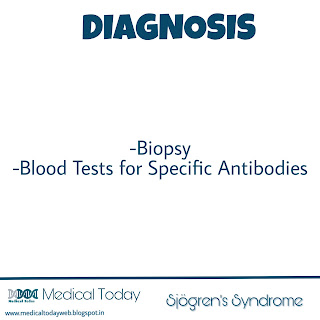Thursday, November 29, 2018
Sunday, November 25, 2018
Thursday, November 15, 2018
SJÖGREN'S SYNDROME
SJÖGREN'S SYNDROME
An Immune system disorder characterised by Dry Eyes and Dry Mouth.
It affects body's moisture producing glands,Recurrent inflammatory process causing permanent damage to the gland and hence the secretary activity of gland affects; and dryness is present in eyes,mouth and skin.
CAUSES
The cause of sjögren's syndrome is UNCLEAR up till now but some Environmental and Genetic Factors are Responsible,such as if patient is exposed to certain Viruses or Bacteria this is trigger factors.
SIGN AND SYMPTOMS.
SICCA SYNDROME characterised in this disease.
Dry Mouth
Dry Eyes
(Keratoconjunctivitis Sicca)
Dry Skin
Vaginal Dryness
DIAGNOSIS
Sjögren's syndrome is diagnosed by Biopsy of the glands to view the certain pathological changes on smear.
Some Blood test is done for specific antibodies.
TREATMENT
Mostly Antiinflammatory Medication is given for the patient.
Artificial Tears are given for relief of pain and itching.
History of SJÖGREN'S SYNDROME
Mikulicz-Radecki (1850–1905) is generally credited with the first description of SS.
The first case in 1892, he described a 42-year-old man with enlargement of the parotid and lacrimal glands associated with a round-cell infiltrate and acinar atrophy. However, the criteria Mikulicz established for diagnosis, often led to misdiagnosis of Mikulicz’s syndrome. Many conditions, such as tuberculosis, infections, sarcoidosis, and lymphoma present with similar conditions to those listed under Mikulicz’s syndrome.Nevertheless, the term "Mikulicz’s syndrome" is still used occasionally to describe the appearance of lymphocytic infiltrates on salivary-gland biopsies.
The first case in 1892, he described a 42-year-old man with enlargement of the parotid and lacrimal glands associated with a round-cell infiltrate and acinar atrophy. However, the criteria Mikulicz established for diagnosis, often led to misdiagnosis of Mikulicz’s syndrome. Many conditions, such as tuberculosis, infections, sarcoidosis, and lymphoma present with similar conditions to those listed under Mikulicz’s syndrome.Nevertheless, the term "Mikulicz’s syndrome" is still used occasionally to describe the appearance of lymphocytic infiltrates on salivary-gland biopsies.
In 1930, Henrik Sjögren (1899–1986), an ophthalmologist in Jönköping, Sweden, observed a patient with low secretions from the lacrimal and salivary glands.Sjögren introduced the term keratoconjunctivitis sicca for the symptom of dry eyes (keratoconjunctivitis). In 1933, he published his doctoral thesis, describing 19 females, most of whom were postmenopausal and had arthritis, showing clinical and pathological manifestations of the syndrome. Sjögren clarifies that keratoconjunctivitis sicca, resulting from water deficiency, had no relation to xerophthalmia, resulting from vitamin A deficiency.Sjögren's thesis was not well received as the Board of Examiners criticized some clinical aspects.
After extensive research and data collection, Sjögren published an essential paper in 1951, describing 80 patients with keratoconjunctivitis sicca, 50 of whom also had arthritis. His subsequent follow-up conference trips pertaining to his paper led to an international interest in SS. The term keratoconjunctivitis sicca was coined by Sjögren himself and began to be identified as SS in literature,although it can now have more general usage.
(source: wikipedia)
Friday, November 2, 2018
Type 1 Diabetes Mellitus
Diabetes mellitus type 1, also known as type 1 diabetes, is a form of diabetes mellitus in which very little or no insulin is produced by the pancreas.Before treatment this results in high blood sugar levels in the body.[1] The classic symptoms are frequent urination, increased thirst, increased hunger, and weight loss.Additional symptoms may include blurry vision, feeling tired, and poor healing. Symptoms typically develop over a short period of time.
CAUSES
Causes are Unknown.
Autoimmune destruction on -Pancreatic beta cells that produces Insulin hormone.
Autoimmune destruction on -Pancreatic beta cells that produces Insulin hormone.
Signs and Symptoms
Heavy thirst
Increased hunger
Dry mouth
Nausea and vomiting
Pain in your belly
Frequent urination
Unexplained weight loss (even though you’re eating and feel hungry)
Fatigue (weak, tired feeling)
Blurred vision
Heavy, labored breathing (your doctor will call this Kussmaul respiration)
Frequent infections of the skin, urinary tract, or vagina.
COMPLICATIONS
Diabetic Retinopathy
Diabetic Neuropathy
Urinary tract infection
Diabetic Keto Acidosis
Diabetic Neuropathy
Urinary tract infection
Diabetic Keto Acidosis
Subscribe to:
Posts (Atom)
Anacardium
You can think of clinically in following Disorders: Disorders like Alzheimer's Disease, Spit Personality Disorder, State of Hypogly...



























